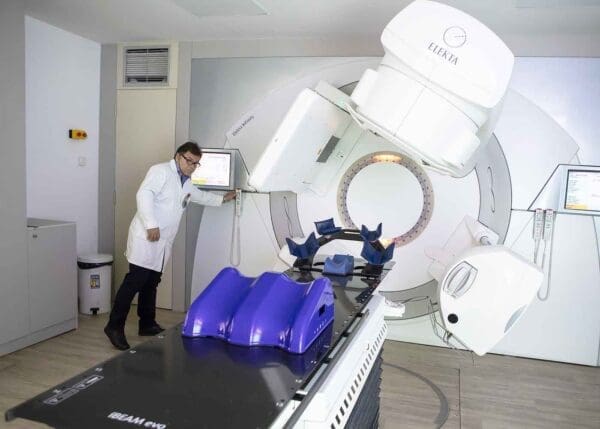01. Radiation Overview
What Is Radiation Therapy for Mesothelioma?
Radiation therapy for mesothelioma uses energy to damage or kill cancer cells. This energy comes in the form of ionizing radiation. Ionizing radiation occurs in two major forms:
- Photon beam radiation is the most common form of radiation cancer treatment. It uses the same form of radiation as an X-ray but at a much higher dose. Photons can release energy at any point along their path. This includes where photons enter, travel through and exit the body. This property allows photon radiation to shrink tumors. But it can also damage healthy tissue.
- Particle radiation uses either electrons or protons to deliver energy to cancer cells. Protons only release energy at a specific distance from their source. Thus, proton radiation can kill cells at the end of its path while causing minimal damage to tissues along the way. This property may allow proton radiation to cause fewer side effects than photon beam radiation.
Note: Proton beam radiation requires specialized equipment. It is not yet widely available.
Some forms of radiation can deliver more energy to tissues further below the skin than others. Thus, some types of radiation may be more effective in targeting tumors far below the skin. Radiation specialists consider the properties of each form of radiation. Doctors keep these properties in mind when prescribing radiation therapy. Radiation may extend life expectancy for some mesothelioma patients.
Benefits of Radiation for Pleural Mesothelioma
Radiation therapy has several potential benefits for pleural mesothelioma patients. As a cancer treatment, radiation can stop or slow the growth of tumors. It may also prevent cancer cells and tumors from growing back after treatment.
Other benefits of radiation therapy include:
- Extending survival: Therapies that incorporate radiation are tied to some of the best known mesothelioma prognoses.
- Improving quality of life: Radiation treatments can help manage symptoms, which boosts quality of life. Radiotherapy may also help prevent surgeries that could negatively impact mental health.
- Reducing symptoms: Radiation can help relieve certain cancer symptoms.
- Shrinking tumors: Radiation can decrease the size of some tumors. This may make it easier for surgeons to remove the tumors.
- Stimulating the immune system: Radiation may help the immune system recognize and fight cancer.
Patients should speak to their oncologists about the potential benefits of radiation therapy. Doctors can explain how the benefits and risks may apply to individual cases.
02. How Radiation Works
How Does Radiation Treat Mesothelioma?
Doctors use beams of radiation to damage DNA in mesothelioma cancer cells. When cancer cell DNA is severely damaged, the cells die and can no longer replicate. This may help prevent metastasis or the spread of mesothelioma.
In general, radiation affects fast-growing cells more quickly than slow-growing cells. Thus, fast-growing cells, such as those in bone marrow and skin, may die shortly after treatment. Slower-growing cells, such as those in the brain or nerves, may take longer to die. Damaged cells may continue to die for days, weeks and months after the radiation treatment.
Doctors may use radiation in an effort to eradicate mesothelioma cancer cells. This is called therapeutic treatment. Doctors may also use radiation to minimize symptoms of mesothelioma. Symptom and quality-of-life motivated treatment is called palliative treatment.
Radiation as Part of Multimodal Mesothelioma Therapy
Doctors often combine radiation therapy with other types of treatment. This combination is called a multimodal treatment plan. Patients may have any combination of surgery, chemotherapy and radiation. Research shows multimodal therapy can lead to better survival in mesothelioma patients.
Radiation may occur as a pre- or post-surgical therapy. In either case, radiation energy can damage or kill tumor cells. This may delay or prevent tumor spread after surgery.
One of the most successful studies of multimodal mesothelioma treatment is the SMART trial. SMART stands for Surgery for Malignant Pleural Mesothelioma After Radiotherapy. Patients in the SMART trial received high-dose radiation therapy prior to surgery.
The SMART method achieved one of the highest reported median survival results for malignant pleural mesothelioma. Read more about the SMART trial in the study spotlight below.
Palliative Radiation Therapy
Mesothelioma patients can receive palliative treatment at any time after diagnosis. Palliative radiation therapy may be used more often in patients with stage 3 or stage 4 mesothelioma. In these stages, doctors use radiation to shrink tumors and reduce symptoms.
Tumors at these stages may press on the lungs and abdominal organs, causing pain and breathing difficulties. Radiation may help improve these symptoms.
Resources for Mesothelioma Patients
03. Types of Radiation
Types of Radiation Therapy
Two main types of radiation therapy treat cancer: internal and external. External radiation uses machines outside of the body to deliver treatment. The internal form uses small implants that release radiation into the tumor. Benefits and risks differ between the two types. Patients should talk with their medical teams about their options.
External Beam Radiation Therapy (EBRT)
External beam radiation therapy is a non-invasive procedure. EBRT uses intense radiation beams to target malignant mesothelioma tumors. A computer guides the beams. Computer guidance helps the radiation to avoid healthy tissue while targeting cancer cells.
Mesothelioma oncologists may recommend specific forms of EBRT such as 3-D conformal radiation or intensity-modulated radiation.
3-D Conformal Radiation Therapy (3DCRT)
3-D conformal radiation therapy (3DCRT) uses imaging scans to plan and deliver the treatment. Doctors may include CT, MRI or PET scans in this planning process. These scans allow the computer to target beams of radiation that follow the shape of the tumor precisely.
By accurately targeting the tumor, 3DCRT can deliver higher doses of radiation and spare healthy tissue.
Intensity-Modulated Radiation Therapy (IMRT)
Intensity-modulated radiation therapy (IMRT) is a form of 3DCRT. Doctors commonly use IMRT for the treatment of pleural mesothelioma. IMRT aims beams of radiation at the tumor tissue from several different directions. However, IMRT uses a larger number of smaller beams versus 3DCRT.
By using more beams, IMRT can vary the strength of each beam. This allows doctors to target higher doses of radiation to certain parts of the tumor. The unique properties of IMRT may allow doctors to more precisely kill cancer while minimizing damage to healthy tissue.
Stereotactic Body Radiation Therapy (SBRT)
Stereotactic body radiation (SBRT) is an advanced form of IMRT. SBRT uses higher doses of radiation in a smaller number of treatments than IMRT. As such, SBRT requires more precision in planning and delivering the therapy.
According to experts, SBRT may provide several advantages over IMRT. SBRT may be more effective in killing cancer cells and less likely to damage normal tissue. SBRT also requires fewer treatments, potentially making it a more economical therapy.
Internal Radiation Therapy
Internal radiation therapy uses medical implants to deliver cancer-killing energy to tumors. It treats cancer locally, only affecting tissues relatively nearby the implant(s). This type of treatment may be called brachytherapy.
Brachytherapy uses seed, ribbon or capsule implants to deliver radiation. These implants may stay in the body indefinitely. The implants may also be removed after a period of time.
According to PubMed, only one medical publication has mentioned brachytherapy and mesothelioma in the last decade. However, other forms of radiation appear frequently in mesothelioma studies. Thus, brachytherapy is rarely used in mesothelioma.
04. Radiation Procedure
The Radiation Procedure and Experience
Each patient’s radiation therapy experience will depend on several factors. The location of treatment, specific type of radiotherapy and patient’s cancer stage can all play a role.
Radiation therapy for mesothelioma often occurs once a day on weekdays. This treatment may take place in a single week. The treatment may also take several weeks.
For example, the EBRT process may include the steps listed below.
Patients receiving SBRT may have a slightly different treatment experience. For instance, SBRT may require fewer treatments than EBRT.
Recovery
Radiation typically does not cause pain during the treatment. Some people continue working during radiation treatment. However, over time and with additional treatments, patients may no longer feel up to working.
Mesothelioma radiation patients should discuss their recovery process with the cancer team. Treatment team members can help the patient understand their unique situation and what to expect from the recovery process.
05. Survival
Mesothelioma Survival and Prognosis After Radiation
Survival of mesothelioma patients after radiation therapy depends on several factors, including:
- Mesothelioma cell type
- Overall patient health
- Stage of mesothelioma
- Type of mesothelioma
- Radiotherapy treatment type
Radiation is not commonly used for the treatment of peritoneal mesothelioma. In other forms of mesothelioma, survival after radiation therapy ranges from about two years to more than ten years.
Patients should discuss their mesothelioma prognosis with members of their treatment team. Mesothelioma specialists can help patients understand their unique situation and expected survival.
06. Side Effects
Side Effects of Radiation for Mesothelioma Patients
All cancer treatments have side effects, including mesothelioma radiation therapy. However, radiation is a local treatment. This means it does not have the same type of whole-body effects as a systemic cancer treatment such as chemotherapy.
Patients should discuss all potential side effects with their physician. Patients should report any side effects that arise during the treatment process.
Skin problems associated with radiation treatment may be called radiation dermatitis. These side effects usually go away after treatment ends. In the meantime, patients may find it helpful to treat their skin gently. This could include wearing soft, loose clothing and protecting the affected skin from the sun.
Experts also recommend patients get plenty of rest during radiation treatment. This can help with some of the fatigue that occurs as the body tries to heal after treatment.
Patients should discuss ways to manage their specific side effects with the cancer team.
07. Eligibility
Who Is Eligible for Mesothelioma Radiation Therapy?
Eligibility of mesothelioma patients for radiation depends on a number of factors, including:
- Mesothelioma stage at diagnosis
- Overall patient health
- Tumor location
Mesothelioma specialists will consider these factors when deciding which, if any, form of radiation to recommend. Patients considering radiation therapy for mesothelioma should consult with an experienced oncologist. Their doctor can explain potential benefits and side effects of radiation treatment.
08. Common Questions
Common Questions About Mesothelioma Radiation Therapy
-
What is the role of radiation therapy in mesothelioma?
- Doctors may use radiation therapy with surgery to treat pleural mesothelioma. The radiation can help shrink the tumor size before surgery. It may also kill remaining cancer cells after surgery. In some cases, doctors recommend it to help relieve mesothelioma symptoms.
-
What is radiation therapy for pleural mesothelioma?
- Doctors use radiation therapy as part of a combination treatment. For example, they may use radiation either before or after surgery. In some cases, doctors use radiation as a palliative treatment. This means the radiation aims to relieve symptoms and shrink tumors. Patients may have radiation at any time after diagnosis.
-
How much does radiation therapy for mesothelioma cost?
- Some data shows the cost of the initial session of radiation is about $4,000. This cost is for lung cancer, and mesothelioma treatments may have a different cost. Patients with insurance may want to find other options to help cover some of these costs. A mesothelioma lawyer can help find other compensation options, including filing a lawsuit.










